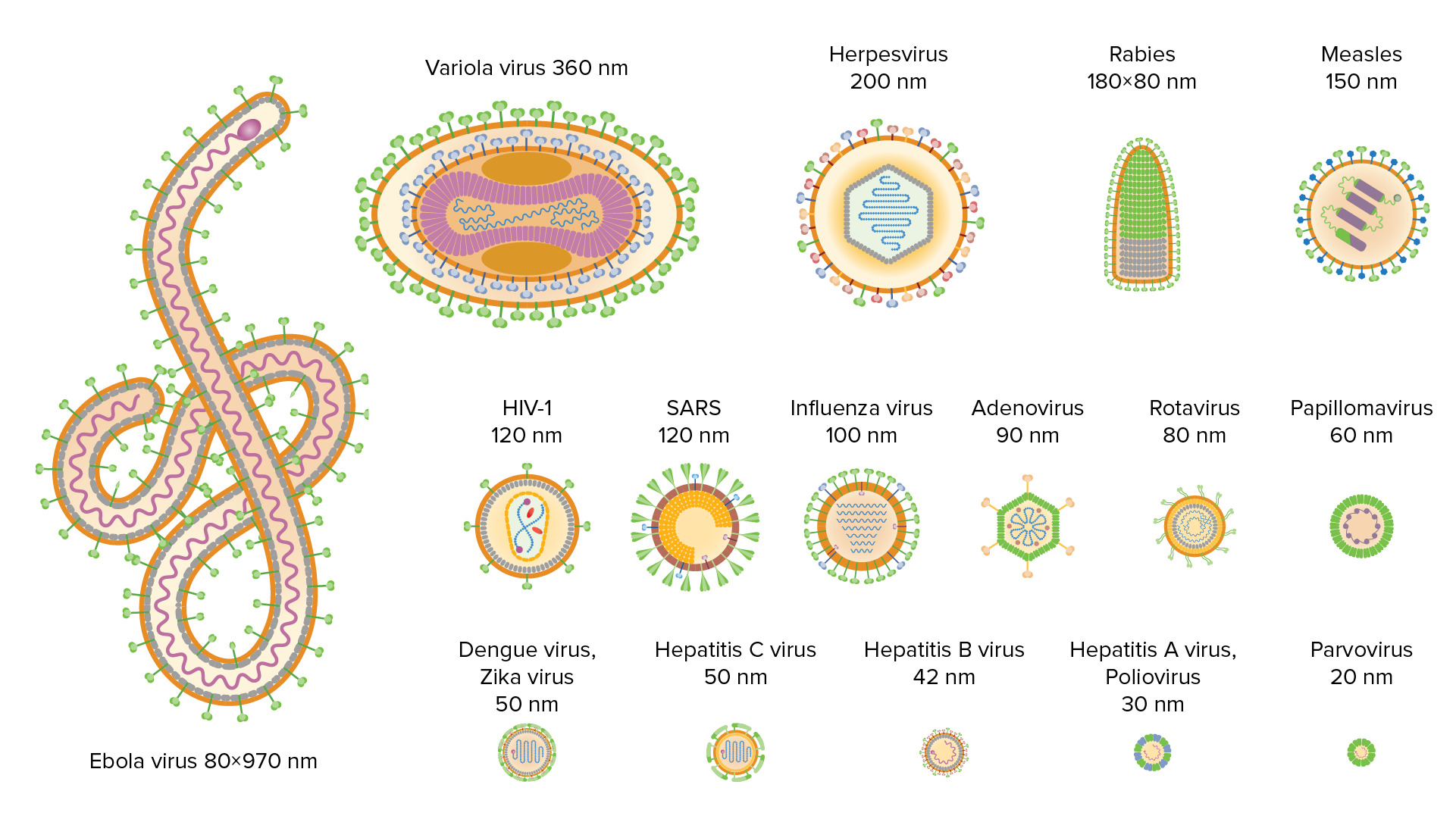Playlist
Show Playlist
Hide Playlist
Positive-sense Single-stranded RNA ((+)ssRNA) Virus – RNA Virus Genomes
-
Slides 05 ViralGenomes MicrobiologyAdvanced.pdf
-
Download Lecture Overview
00:01
We now move onto viruses with single-stranded
RNA genomes, and we are going to look first
at those of positive polarity, this is mRNA
sense polarity. One family, the Picornaviridae,
contains the important pathogen poliovirus,
about to be eradicated. It would only be the
second virus to be eradicated after smallpox.
The Caliciviruses, if you've ever gone on
a cruise and gotten diarrhea, you can thank
the caliciviruses, in particular Norwalk virus.
00:30
They cause outbreaks of diarrheal disease
on cruise ships, schools and colleges, any
institutional setting. Then we have the Coronaviruses.
The SARS coronavirus came out of China and
caused a global outbreak in the 2000s, the
MERS coronavirus currently causing outbreaks
of serious respiratory disease in the Middle
East. Looks like it goes from camels to people.
00:59
The Flaviviruses have a number of substantial
human pathogens, yellow fever virus, mosquito
transmitted liver disease, West Nile virus,
also mosquito transmitted, hepatitis C virus
are examples of Flaviviruses. Flavi comes
from yellow, which is the color of someone
who has yellow fever, because of the jaundice
being caused by virus infection. And finally
the Togaviridae has important viruses like
rubella virus, and equine encephalitis virus.
01:31
So let's take a look at how these genomes
replicate. Again, they are plus sense RNA
genomes, you can see on the left part of the
slide there, it's a green line shaded gray,
that genome can be translated directly to
make protein by the host cell, which can go
on to assemble new virus particles. Of course
just like every other virus we need to make
additional genomes and so what happens is
simply the plus strand is copied to make a
minus strand RNA, you can see in yellow there,
which is copied again to make more plus strands,
and again, what enzyme does this? Is it a
cell enzyme? Absolutely not! Cells can’t
do this, it's a virus enzyme, and that minus
RNA has no other function except to be a template
for the synthesis of more plus strands. Now
these viral genomes are naked in the virus
particle, there's no RNA polymerase. Now remember
the real virity with double-stranded RNA,
they contain an RNA polymerase in the particle,
because the double-stranded RNA could not
be translated, these genomes are plus mRNA,
they can be translated as soon as they get
into a cell. so you don’t need to have a
polymerase there. You can make the polymerase
from translation of the genome. So this is
what distinguishes the two kinds of RNA viruses
with or without a polymerase, whether or not
the mRNA is accessible by the host cell translation
machinery. Now these single-stranded plus
sense RNA genomes vary in size. The Coronaviridae
are among the largest that we know of, 28
to 33 kb in size. And these are typical messenger
RNAs, they have a cap at the 5 prime end,
they're polyadenylated at the 3 prime end.
03:14
The Flaviviridae plus stranded RNA genome
is somewhat smaller, 10 to 12 kb in length.
03:20
Again it has a Cap at the 5 prime end, curiously
the Flavivirus genomes do not have a poly
A at the 3 prime end. The Picornaviridae genomes
are 7 to 8 and a half kb in length. They are polyadenylated.
03:33
But at the five prime end they don't have
a cap, rather they have a small viral protein.
03:38
And finally the Togavirus plus stranded RNAs
are from 10 to 13 kb long with a five prime
cap and a three prime poly A tail.
03:48
Let's move on to single-stranded RNA viruses
with a plus sense genome, except these viruses
go through the DNA intermediate. And there
is one virus family containing these kinds
of viruses, it is called the Retroviridae
or retrovirus family, and the picture of the
virus you see here is an example of a retrovirus.
There are two human pathogens in this family.
04:15
They're very important pathogens, one is HIV,
human immunodeficiency virus, of course we’re
in the midst of a huge HIV pandemic, over
33 million people are infected at this moment
in time, and then the other human retrovirus,
Human T-lymphotropic virus or HTLV, also causes
millions and millions of infections as well.
Now these are very unusual viruses, because
they are plus stranded RNA genomes, but they
go through a DNA intermediate. So you can
see at the top is the plus stranded RNA, and
here is an example of a plus RNA that is not
a messenger RNA. It could be, it could be
translated readily, but when this comes into
a cell by a virus infection, it is not translated;
it is sequestered from the host ribosomes,
and instead is copied into a minus strand
DNA by the enzyme reverse transcriptase. That
enzyme, as I mentioned earlier, Nobel prize-winning
discovery, was first discovered in the retroviruses
and subsequently found to be in the hepatitis
B viruses as well. Now you can predict what's
going to happen next, because a minus DNA
of course cannot be made into mRNA, you can
only make double-stranded DNA into mRNA, so
that minus DNA is made double-stranded, it
can then be copied into mRNA which can be
made into proteins. And to make more virus
genomes, which are plus RNA, a subset of those
messenger RNAs can simply be packaged.
05:52
So the retrovirus genome is shown schematically
on the left of the slide. It is around 7 to
10 kb long and it's a typical mRNA with the
five prime cap and a three prime poly A tail,
and I say typical because again it is not
translated when it enters a cell, it is reverse
transcribed, and only later are the mRNAs
translated when they are made from double-stranded
DNA.
About the Lecture
The lecture Positive-sense Single-stranded RNA ((+)ssRNA) Virus – RNA Virus Genomes by Vincent Racaniello, PhD is from the course Viruses.
Included Quiz Questions
Which family of viruses is most commonly associated with jaundice and liver disease?
- Flaviviridae
- Picornaviridae
- Caliciviridae
- Togaviridae
- Coronaviridae
What kind of genome must a virus be composed of for it to be able to replicate without carrying its own polymerase?
- Positive-sense mRNA
- Negative-sense mRNA
- Double-stranded mRNA
- Gap-strand mRNA
What is the size range of the genomes of viruses in the Coronaviridae family?
- 28 to 33 kb
- 24 to 28 kb
- 22 to 30 kb
- 33 to 36 kb
- 28 to 40 kb
What is a unique characteristic of the genome of members of the Flaviviridae family that is not shared by other single-stranded +RNA viruses?
- They do not have a poly(A) at the 3-prime end.
- They are composed of only the positive strand.
- They have a poly(A) at the 5-prime end.
- They have a cap at the 3-prime end.
Customer reviews
5,0 of 5 stars
| 5 Stars |
|
5 |
| 4 Stars |
|
0 |
| 3 Stars |
|
0 |
| 2 Stars |
|
0 |
| 1 Star |
|
0 |




